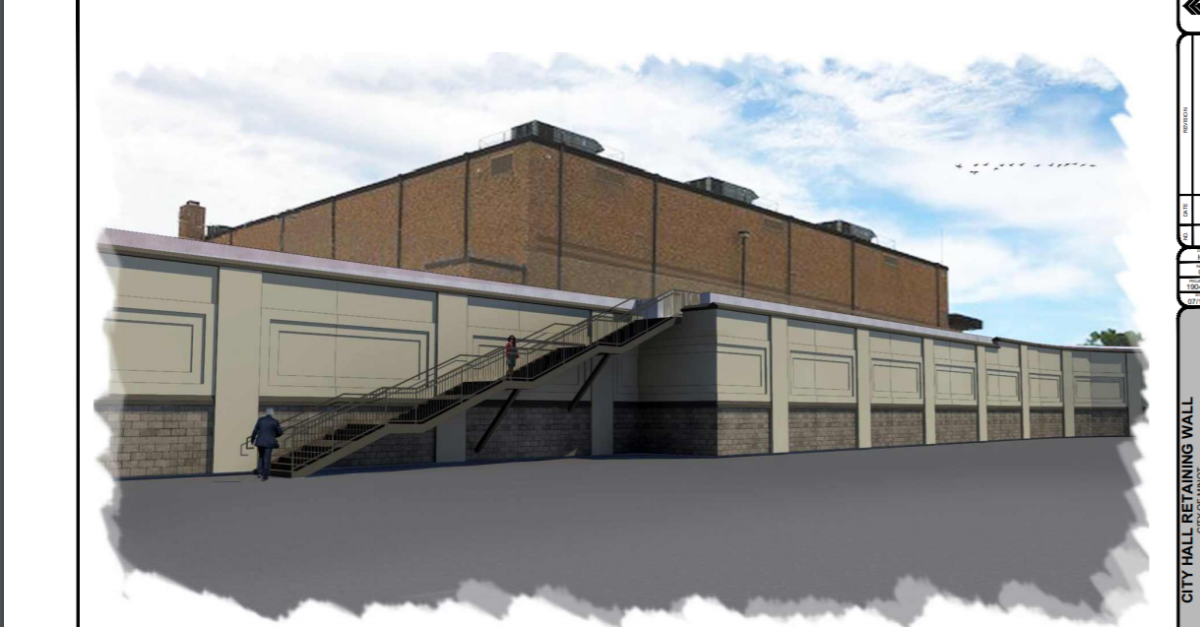“Anybody can become angry — that is easy, but to be angry with the right person and to the right degree and at the right time and for the right purpose, and in the right way – that is not within everybody’s power and is not easy.” — Aristotle
Authors note: the post was published with limited review so as to get it public prior to today’s City Council meeting. It will be updated with additional pictures and media by Tuesday at 5:00 pm.
Minot, now is your moment. But instead of being angry, be concerned. I am concerned about the direction of a big, expensive project. If after reading this, you share these concerns, reach out to your Council and share thoughts. Stopping, slowing, or adjusting a project on the front-end is much less costly than lamenting it after it’s too late.
This is the project — a new City Hall wall
I’m talking about a City-proposed project to remove the rock-and-concrete slope around City Hall and replace it with retaining walls. The project has been tracking in our CIP (Capital Improvement Plan) since the winter of 2016, but it’s only now that the full cost of the project is understood.
What’s being proposed is simple:
- Remove the rock-and-concrete slope facing.
- Remove the slope.
- Add a retaining wall in the approximate upper location of where the rock-face meets the Auditorium parking lot.
- Add parking with the new space recovered underneath.
This proposed work is estimated to cost $4.7 million. This cost has grown considerably since initial estimates ($2.8 million) and since design work was approved to begin this past winter. In exchange for these dollars we will get:
- A circumstance of deferred maintenance addresssed. The rock-and-concrete face is degraded and needs attention. There is no arguing this point.
- New parking for the current City Hall and Police Station. The exact amount is to be determined because the exact design is not finalized, but estimates place the number of new parking spaces at close to fifty (50).
- Aesthetic improvements.
At this moment and for the past year, this Alderman is wildly opposed to green-lighting this project. Let me illustrate why.
A project with a head start on the conclusion from the very beginning
As stated earlier, this project hit the City’s fall in the Winter of 2016. At the time, the slope-failure along the Southside of Hillcrest Drive in NE Minot prompted the City to examine other areas of town where steep slopes were covered by a rock and mortar facing. KLJ was hired as our consultant to shepherd the project; Braun Intertec was hired by KLJ as a sub-consultant — these guys are the slope-stability experts.
The 108-page report that was delivered to the City in the spring of 2016 can be viewed here, and the conclusions we can draw from it today are crystal clear — this project was steered toward the construction of a wall and creation of new parking from the beginning. Here’s the quote from page 45, the cover letter Braun Intertec provided to KLJ on February 9, 2016:
We were informed that you plan to use a Redi-Rock type MSE wall system to replace the existing retaining walls. The following report provides our recommendations for retaining wall structure support, and construction considerations for the project.
This is a critically important statement because it states that the decision to build a wall had already been made as of February of 2016. And as a result, we did not explore the viability or get cost estimates of any other alternatives from our slope-stability experts. Though the current rock-and-mortar system successfully stabilized the slope for more than 60 years, we did not evaluate the cost or viability of replacing the current facing with exactly the same system — until very recently.
Had the above paragraph of Braun Intertec’s letter read something like, “We were contracted to evaluate slope stability and provide alternatives, estimates, and recommendations for mitigating risk associated with global slope failure” I doubt you would be reading this commentary today.
Unfortunately, when a project is directed — at the outset — toward a specific conclusion, it means that all the information built upon that assumption is — at best — incomplete or — at worst — wrong. This is a terrible foundation on which to build faith in a $5,000,000 project.
Decisions fueled by fear, misled by jargon, and just plain under-informed
If you ever have the privilege of serving in an elected role, one thing you’ll learn quickly is it’s difficult to vote against the system. We — the elected officials — are laypeople. Those who we hire to work for us are professionals. Would you stick out your neck to oppose the opinion of a professional engineer if you were a plumber? But question their conclusions we must.
Here are just some of the conclusions and comments both implied and direct that have no doubt influenced Council decisions and kept this project moving over the past year:
- Another Hillcrest Drive: Pictures of slope failure are scary; they are a call to action themselves. But beyond the rock-and-mortar slope-face covering, the common circumstances between these projects are few. Hillcrest Drive near the slope failure (based on my analysis using the City’s GIS system) had a slope of 9.5’ horizontal to 12’ vertical. That equates to a 0.8H:1v slope or an angle of about 51 degrees. By comparison, the steepest angle of slope around City hall is approximately 38 degrees. Is that a big difference in terms of global slope stability? I don’t know, but I suspect it might be. Right now, I’m being shown scary pictures of a fallen 51-degree slope and encouraged to spend $5 million to fix a 38-degree slope. I’m not yet convinced these are the same.
- “Vertical and Near Vertical Slopes” Repeatedly during Council consideration of this project over the past year the slopes around City Hall have been referred to as “vertical or near-vertical. This is not accurate. According to the engineering report provided by Braun Intertec, the steepest slope around City Hall is 1.3’ horizontal to 1’ vertical. This translates to a slope of about 38-degrees. It’s many years since I took geometry, but I do remember that a slope of 38-degrees is a long way from “vertical or near-vertical”. This description is misleading, it inspires fear. This is not a foundation for sound decision making.
- A vegetated/grass slope is not viable. Going back to last year, I have advocated for evaluating whether the slope can be stabilized with grass or another native, low-maintenance species. At our most recent meeting, we were shown a diagram that indicated that the only viable slope for vegetated covering was 4’ horizontal to 1’ vertical. This is the slope our consultants imply is required to provide maintenance; its construction would require encroachment into the Auditorium and 3rd Ave SW. Encroachment into the Auditorium looks scary and very expensive, but is a 4h:1v slope the only viable option? Could we consider a steeper slope? An example: the slope above Magic City Campus is close to 3h:1v and is actively maintained. If we look in other places like the Southside of Town & Country, we quickly find examples of steeper slopes that have been stable for decades. Yes, they are undoubtedly difficult if not impossible to maintain. The question we don’t have an answer to is what would they cost and are they viable in this circumstance at City Hall?
- Slope-stabilization through other methods/Local contractors aren’t capable. At our August 5 meeting, I asked if we had contemplated slope-stabilization methods such as:
What the Council was told was that these options were informally evaluated, but found to be not viable because local contractors were not capable of installing them. That’s a statement I’d like heard and answered by local contractors themselves through the Minot Builder’s Association. But beyond that, in the case of a cellular confinement system, we have at least one example of this product in place in Minot right now underneath the Duane Carlson Field bleachers. Is that an apple to apple slope comparison? Probably not. But it does cast some doubt on our consultant’s assumptions about the capabilities of local contractors.
The politics of hub city funding and lost opportunity
To remind you, when initially advanced by Council last December, the estimated cost was ~$2.8 million. The funding source was expected to be entirely hub city funding. This is the funding source we spent nearly 18-months lobbying the legislature for an adjustment to the state’s revenue distribution equation. Through extraordinary hard work; Minot was successful. As a result, we expect to see considerably more state dollars each year. These dollars are tasked to this project.
But have we thought about how legislators will look upon this project when in the future they ask us how we spent those dollars? Many legislators including those locally were concerned that funding municipalities to the levels contemplated in the Prairie Dog would lead to wasteful spending at the local level? How defendable is this project given that concern?
And that was a concern at the original estimate and funding source. Now, with the revised estimate, we’re being asked to spend $2.9 million in Hub City funding as well as $1.8 million in cash reserves. We’ve also recently learned (due to Alderman Podrygula’s extraordinary due diligence on this project) that the cost to replace with an in-kind rock-and-mortar system would cost roughly $3 million. That amounts to a nearly $1.8 million dollar savings. Have we considered what other projects that $1.8 million might be applied to? Should we consider those types of things before advancing a project with a wildly escalating cost?
It’s an important reminder that whenever we spend on one project, it is at the expense of another. This is known as opportunity cost. By investing in one area, we lose the opportunity to invest in some other area. Are fifty new parking spaces at City hall worth the cost of saving the Anne Street Bridge? How about taking that $1.8 million and investing it in the scourge of all Minot roads — 1st Ave North from 3rd Street to the Amtrak Station? We have properties there paying property tax that aren’t even served by a public right of way!
It’s easy to see where my passion lies, but I use these projects only as an illustration of lost opportunities associated with this ballooning-cost project. What do you care about that is worthy of a $1.8 million budget-line conversation?
Is it fair to ask about City Hall?
And still, perhaps the biggest question of all as we contemplate this investment in a wall and new parking — what is the future of City Hall? Certainly, given a future that holds a City Hall expansion on this site, it’s easy to see a demand for added parking, but what if City Hall moves? When City Hall employees move out, they’ll give up at least 40-50 parking spaces (according to the City Hall space analysis that shows City Hall providing space for 56 staff members currently). Will 90 new spaces be required for the police department in the future?
The question of City Hall expansion is intrinsically linked to the question of what to do with the City Hall wall. To divorce them at this point when they are now naturally arising on the same timeline is not an example of thoughtful government. We should demand better from the City.
Editorial: You’ve just read my reasons for doubting our present course on this project. Here’s where I actually stand: I do not oppose addressing the degrading nature of the current slope, and I do believe we should take steps to mitigate water cascading over the North/South portions of the wall through drainage improvements at the top. We have already done much of this on the East/West portions through work on the 6th Street Underpass. Beyond that, we should evaluate all viable alternatives for ensuring the global slope stability that we currently observe is maintained.




I agree with you.
My understanding was city hall was moving as part of the resilience project. Doesn’t seem very effective use of limited funds. What would a new police station cost in a different location? More than 5 million?